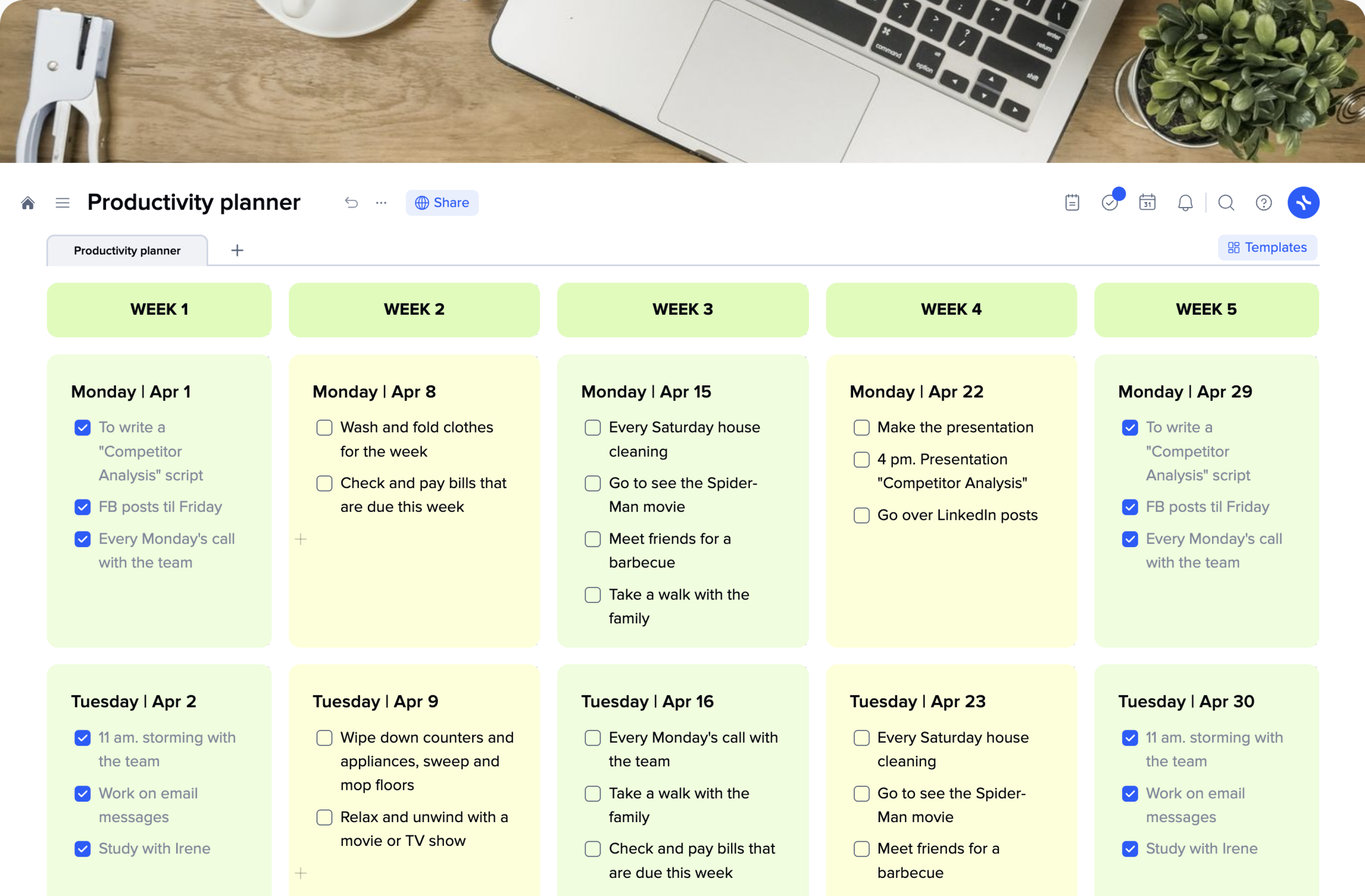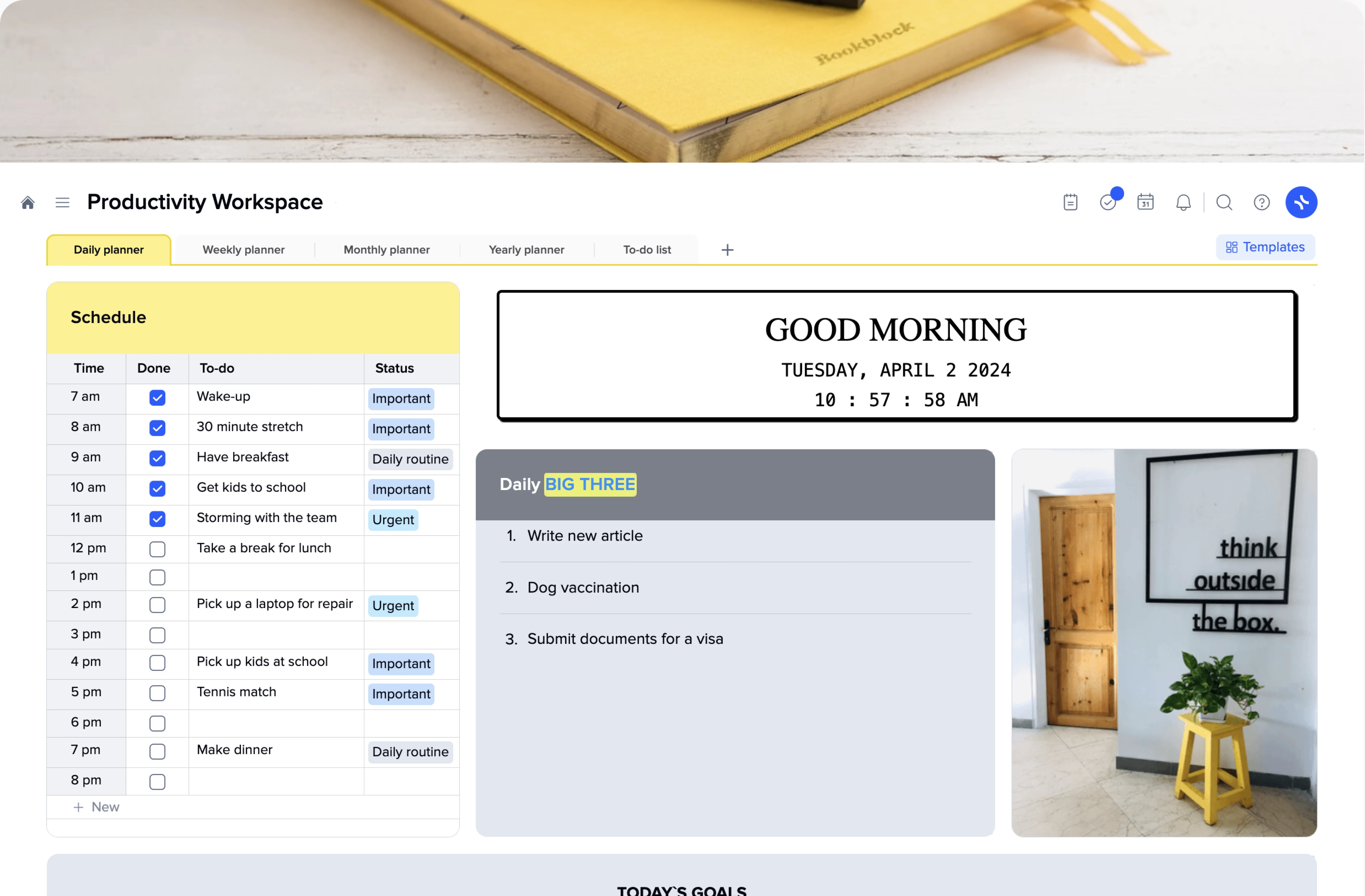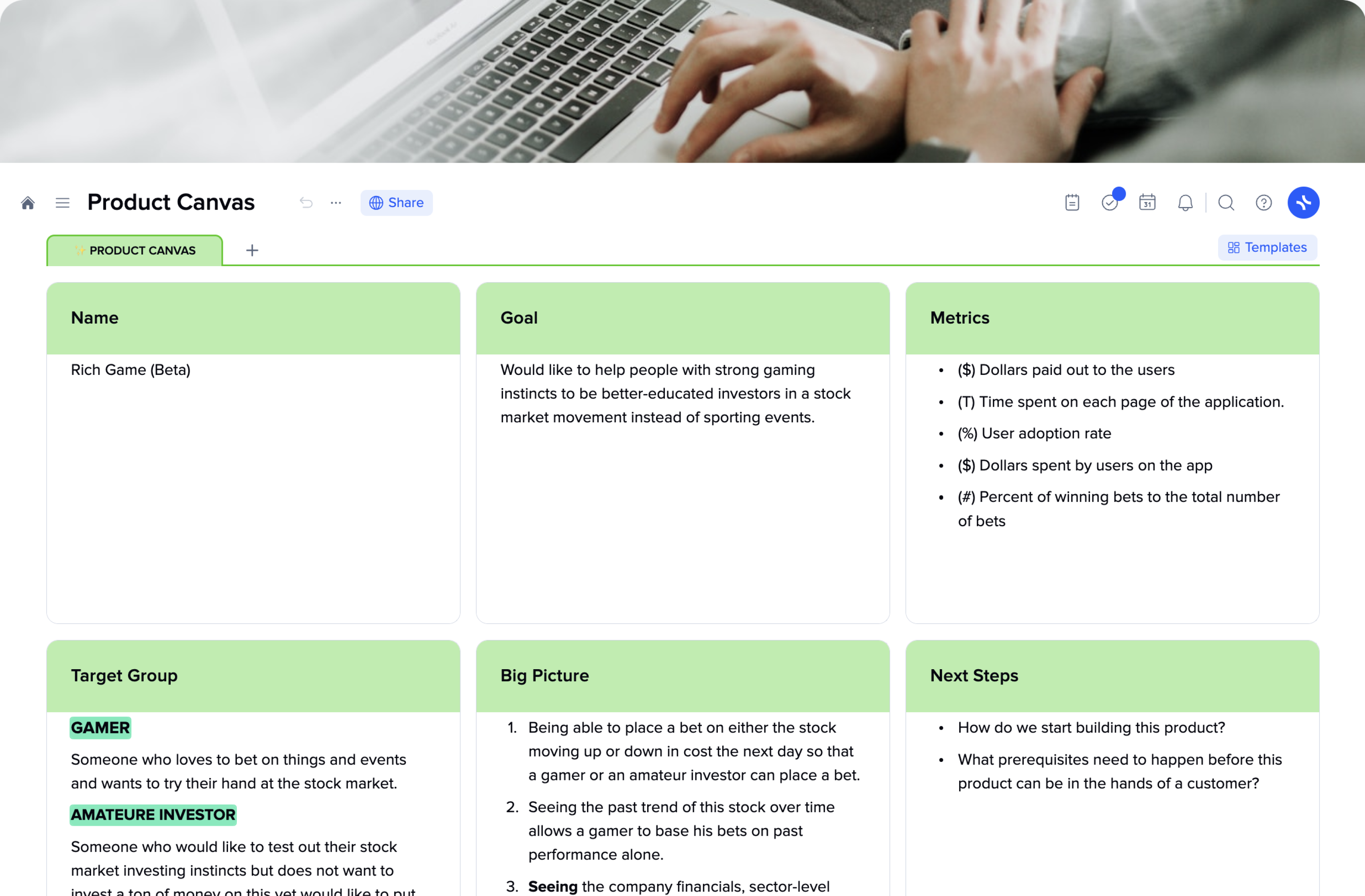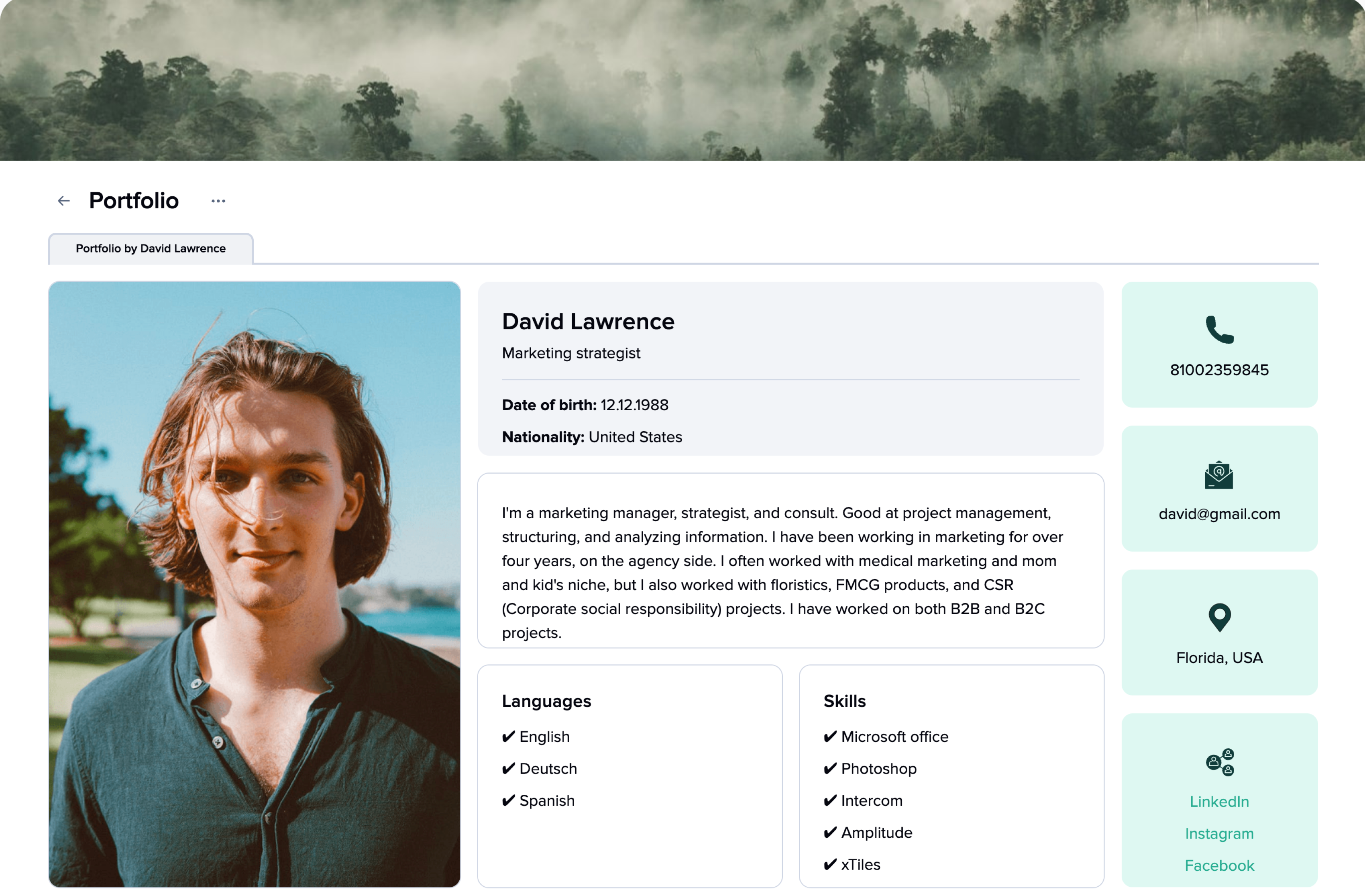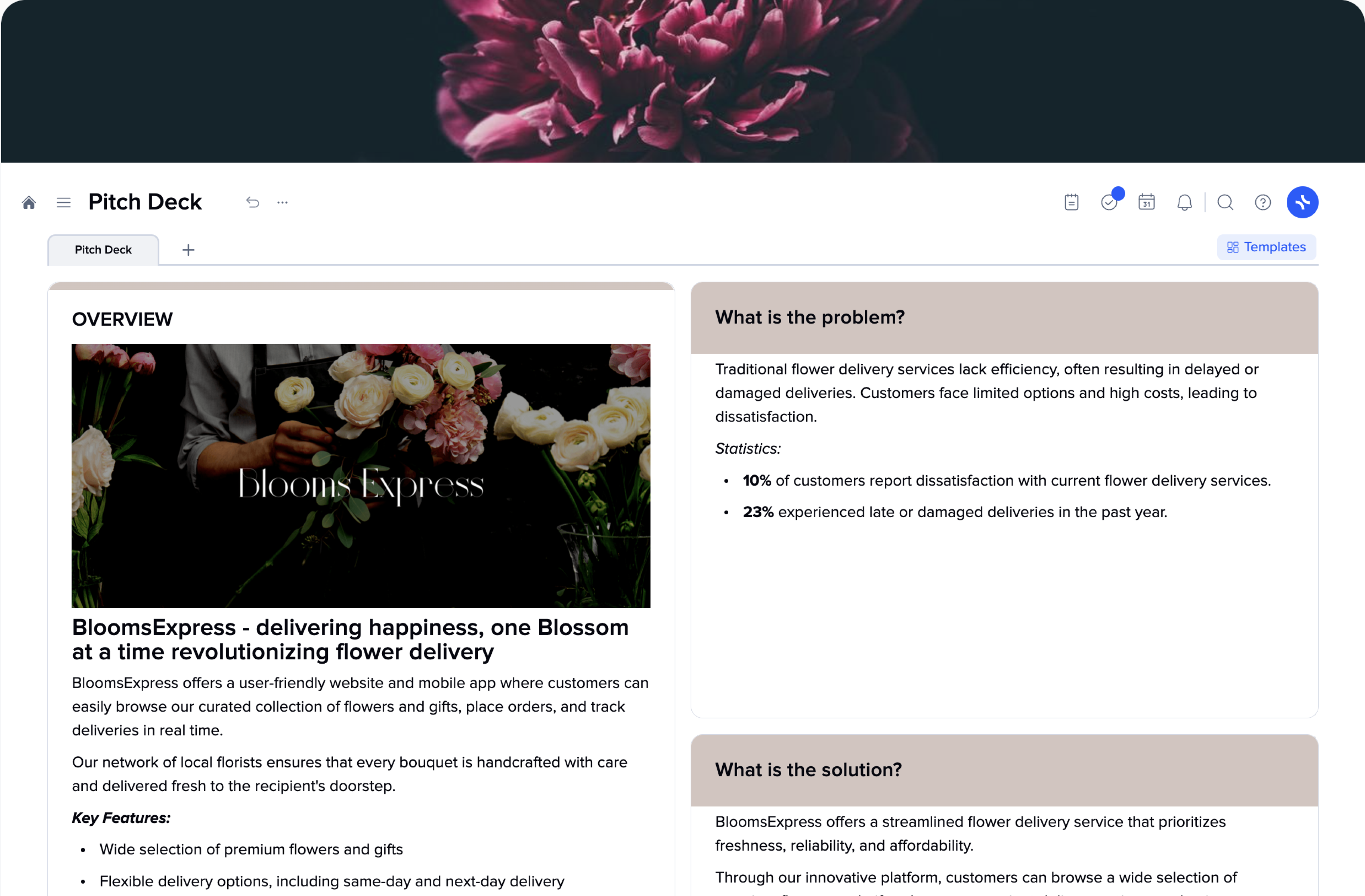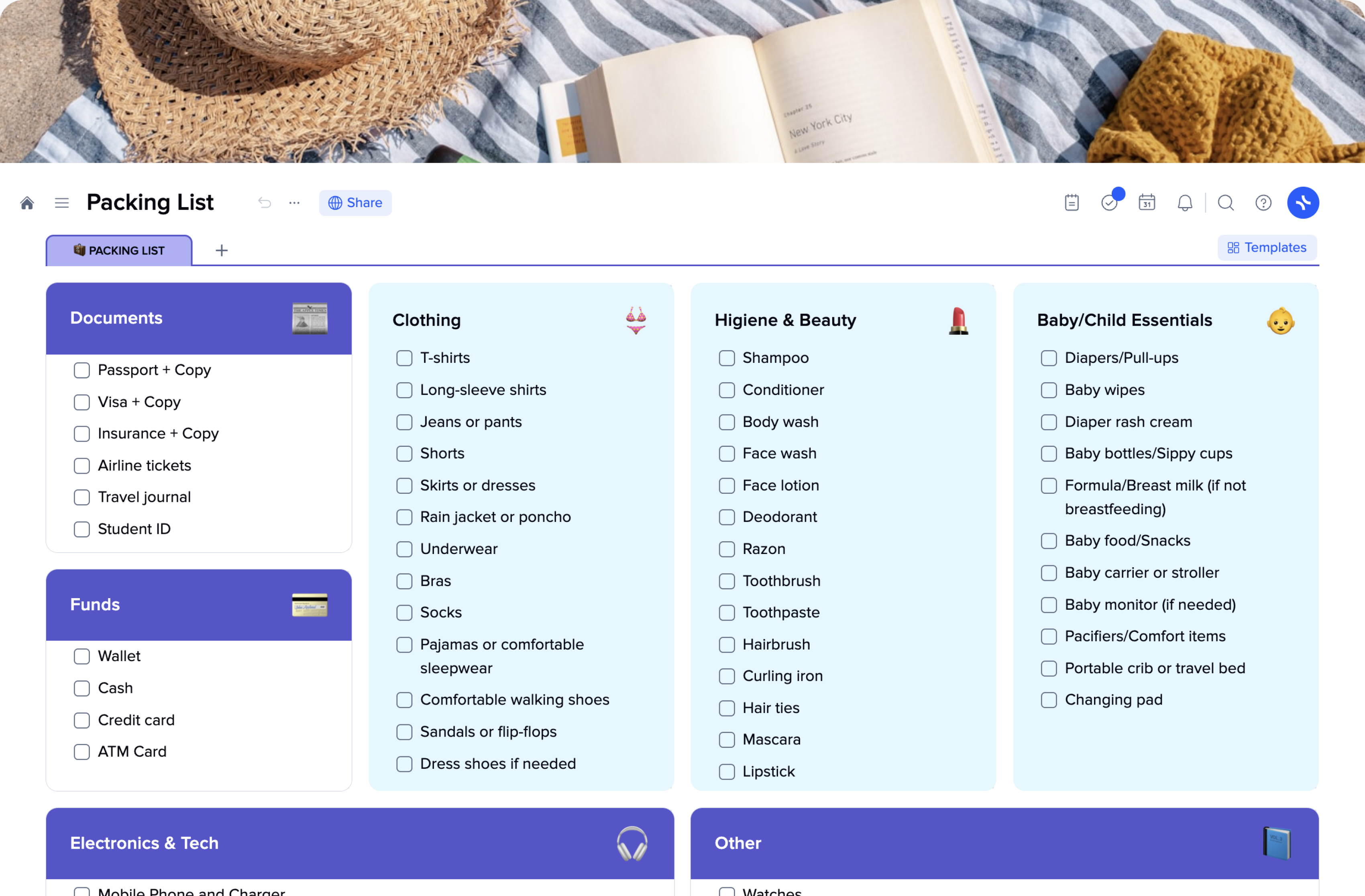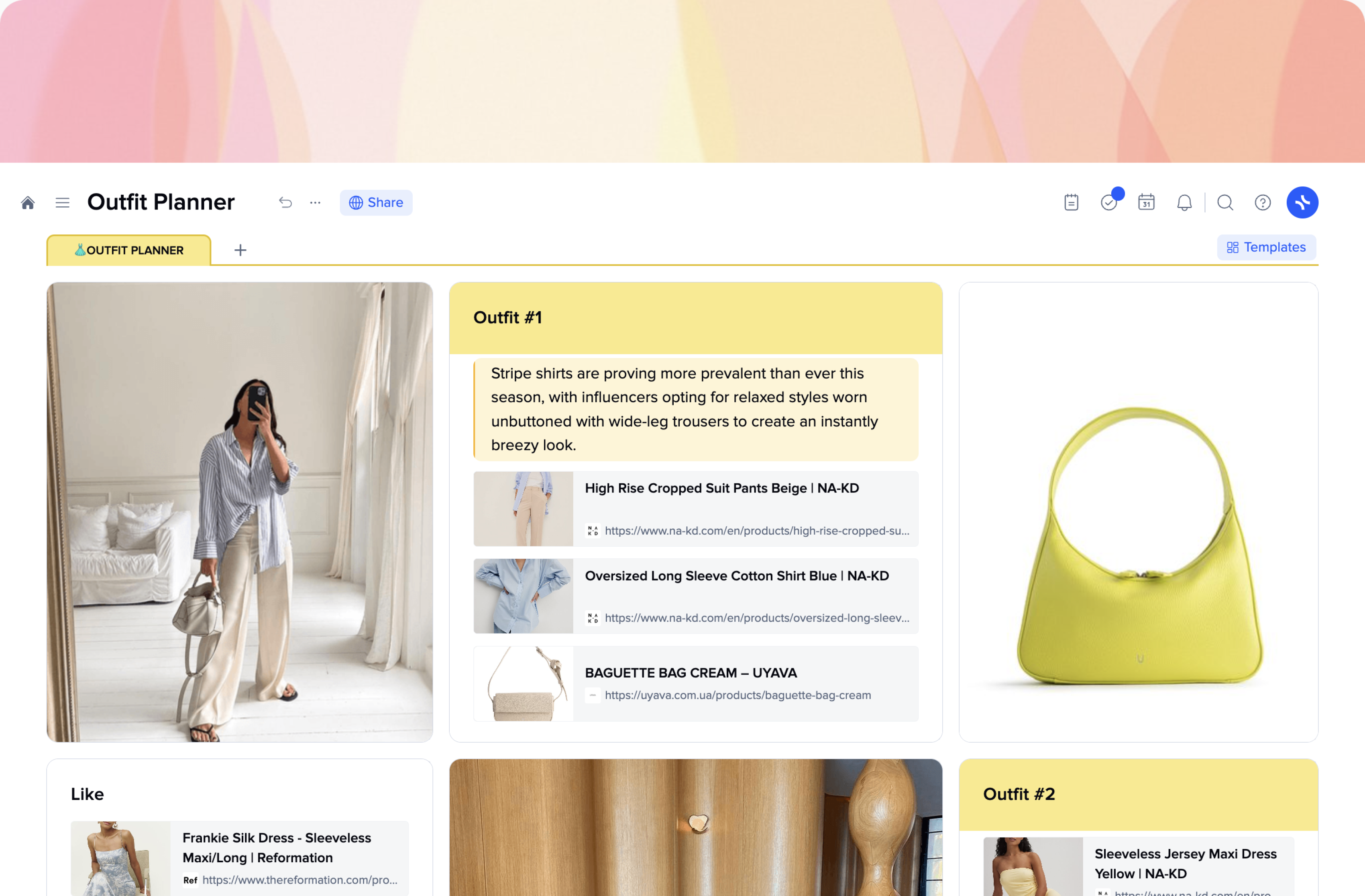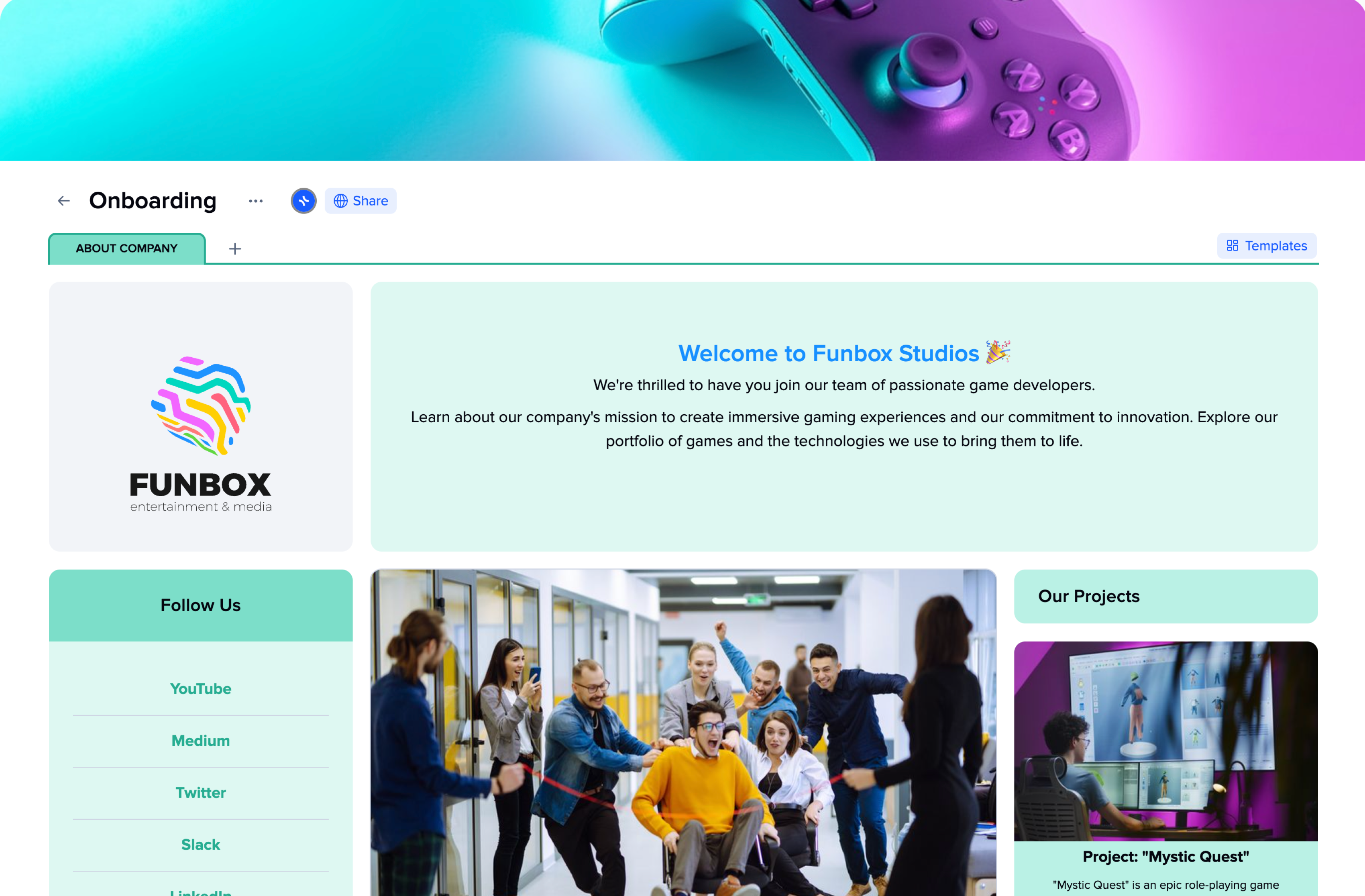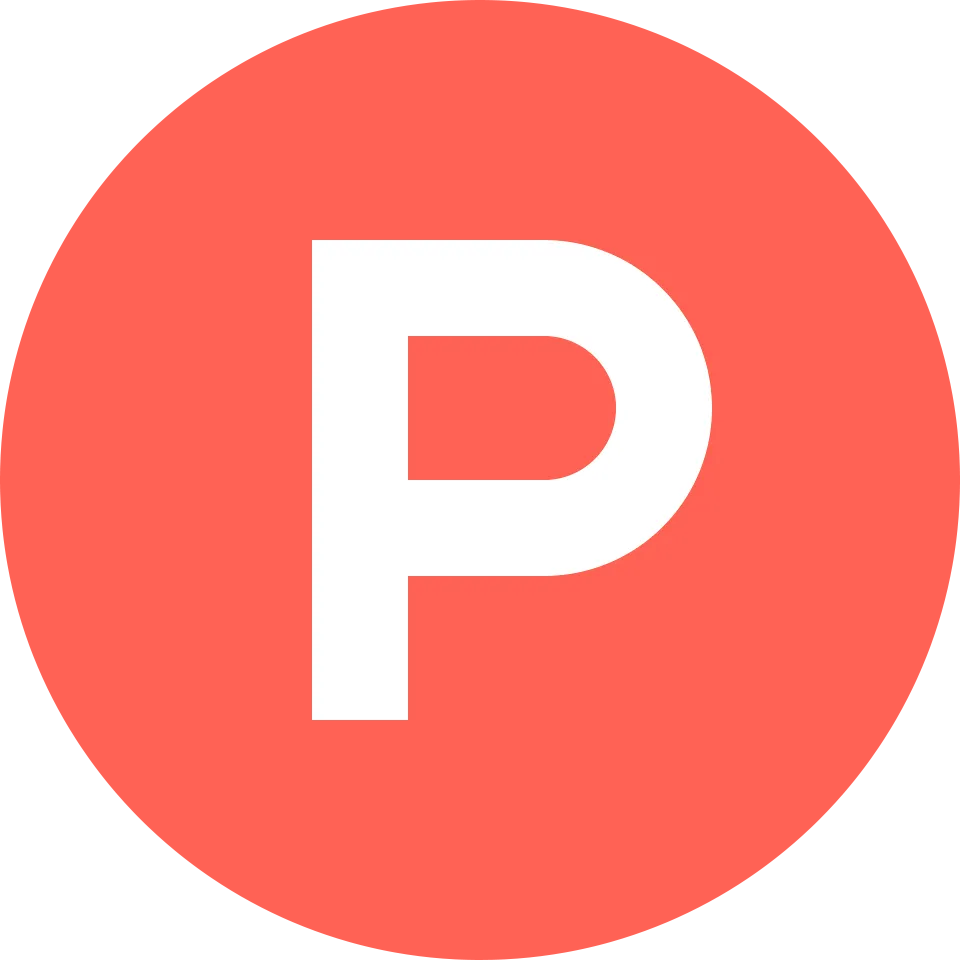Onboarding Template
Do you remember your first day at work? How did that feel? Were you anxious or relaxed? Probably, the first. Few people wouldn’t feel tension during such important moments. That’s why we need onboarding.
Onboarding ensures smooth integration into new teams and organizations for new hires. Companies, in turn, get a new employee that understands and shares company culture, goals, and style of work.
Even though onboarding is necessary, many companies and organizations still struggle with establishing the process and making it as easy for new hires as possible, which might lead to losing valuable employees at the early stages of their employment.
An onboarding template is what makes everything easier for the people responsible for building the process. The xTiles Onboarding Template serves as a basic structure to provide people with the main information for new employees. It helps you gather all the helpful data, resources, and links to help people become part of the company.
What does “Onboarding” mean?
New employee onboarding is the process of acquainting new employees with an organization’s expectations, behaviors, and culture. A successful onboarding not only enhances the new hire experience but also establishes the foundation for loyalty, leading to positive outcomes for the company’s bottom line. And strong employee loyalty, in its turn, increases the likelihood of long-term commitment and engagement.
However, the impact of employee onboarding goes far beyond these immediate benefits. Its influence extends throughout the entire employee journey, beginning even before Day 1 and continuing until their last experience with the company. In essence, onboarding encompasses the entire employee’s lifecycle within the organization.
Effective onboarding starts prior to an employee’s first day, involving activities such as pre-boarding communication, paperwork completion, and setting expectations. This early stage sets the tone for the employee’s experience and prepares them for a seamless transition into their role.
Once the employee joins the company, onboarding continues with comprehensive orientation programs, training initiatives, and introductions to colleagues and organizational practices. These activities aim to facilitate smooth integration, foster a sense of belonging, and equip the employee with the necessary knowledge and resources to thrive.
However, onboarding doesn’t conclude after the initial period. It extends into ongoing support, feedback, and development opportunities throughout the employee’s tenure. Continuous onboarding efforts ensure that employees remain engaged, motivated, and aligned with the company’s objectives, nurturing their professional growth and commitment.
By viewing onboarding as a comprehensive process that spans the entire employee journey, organizations can cultivate an environment of continuous learning, development, and engagement. This holistic approach to onboarding creates a solid foundation for a successful and enduring employee experience, leading to enhanced productivity, higher retention rates, and ultimately, a positive impact on the company’s overall performance.
In summary, onboarding encompasses more than just the initial introduction of new employees to the organization. It encompasses the entire employee journey, from pre-boarding to offboarding. By recognizing this comprehensive scope and implementing effective onboarding strategies, organizations can create a supportive and engaging environment that fosters employee loyalty, growth, and long-term success.
How has onboarding changed during the pandemic?
The onset of the pandemic necessitated significant changes in the way onboarding is conducted. Organizations were compelled to adapt and pivot in order to maintain some semblance of continuity amidst the chaos.
The onboarding landscape is no longer the same as it was before the COVID-19 era. The current circumstances demand that companies discard the traditional rule book and reimagine what effective onboarding should look like. Now, more than ever, there is a pressing need for a shift in employee onboarding and employee experience to ensure their effectiveness in this new reality.
The pandemic has brought forth numerous challenges and considerations that must be addressed in the onboarding process. Remote work setups, virtual interactions, and distributed teams have become the norm. As a result, companies have to modernize their traditional onboarding processes to accommodate these changes.
Virtual onboarding platforms, tools for video conferencing, and various digital resources have become inevitable for the success of this new onboarding. They enable remote interactions, virtual training sessions, and the seamless sharing of information and resources.
Why do both parties need onboarding?
The purpose of onboarding employees goes beyond a mere introduction to the organization. It encompasses a series of well-planned events and milestones designed to ensure a smooth transition and integration for new hires.
The onboarding facilitates and harnesses the employees’ understanding of the company, familiarizes them with their new colleagues, and clarifies their specific roles and responsibilities.
In contrast to employee orientation, which is typically a one-time event, onboarding is a comprehensive process that unfolds over weeks or even months. While orientation may cover essential company information such as security badges and employee handbooks, onboarding extends from the moment an employee signs their contract and continues for an extended period. Its aim is to equip new hires with the necessary skills and knowledge to excel in their new position.
The responsibility for conducting onboarding often falls upon human resources or the learning and development team. A well-defined and organized onboarding process is crucial in fostering a sense of confidence and competence among new employees, enabling them to navigate their roles effectively and feel a sense of belonging within the company.
The fact that an unorganized and flawed onboarding process can have a devastating effect on your business isn’t surprising. New hires who don’t have a positive experience with their onboarding are likely to seek new job opportunities where everything is straightforward and clear. This way, you waste resources on finding and teaching new people without any profit.
Clearly, onboarding holds significant importance. The decisions you make while constructing your onboarding process have far-reaching implications for employee retention, learning, performance, and ultimately, the financial health of your company.
Effective onboarding directly impacts employee retention by establishing a solid foundation for their long-term commitment. A well-designed onboarding program creates a sense of engagement, purpose, and belonging among new hires, reducing the likelihood of early departures and costly turnover. By investing in a comprehensive onboarding process that nurtures employee satisfaction and loyalty, you can mitigate the financial strain associated with frequent employee replacements.
Additionally, the onboarding process is crucial for fostering employee learning and development. It helps new hires acquire new skills and knowledge and set the available ones according to their new role. It also helps people accelerate integration into their roles, allowing them to contribute effectively and reach optimal productivity faster.
Benefits of the flawless onboarding process
The impact of onboarding, whether positive or negative, reverberates throughout an employee’s entire tenure at your company. By investing in creating a positive and valuable onboarding experience, you not only gain the appreciation of new hires but also enhance the overall well-being of your organization.
- Onboarding strengthens early retention:
Investing in employees’ career development from the outset is crucial. New hires may start their job with uncertainty and skepticism if lacking sufficient support, which might convince them to leave in the early stages. By providing opportunities for growth during onboarding, you demonstrate your commitment to their professional advancement, increasing their satisfaction and reducing the likelihood of premature departures.
- Onboarding streamlines administrative tasks:
Effective onboarding processes leverage organization and technology to expedite new-hire administrative tasks. Commencing a new job typically involves numerous administrative responsibilities, such as setting up accounts, completing tax forms, signing documents, and joining the payroll. These tasks can be tedious and, without an efficient process in place, hinder the enthusiasm and momentum of new hires. By optimizing the onboarding experience, you can swiftly navigate these administrative requirements, ensuring a seamless transition into their roles.
- Onboarding accelerates productivity:
New employees require a period of acclimation to acquire skills, familiarize themselves with tools and processes, and understand how your company operates. Onboarding provides an ideal opportunity to expedite this process, enabling them to contribute to their full potential as quickly as possible. By equipping new hires with the necessary guidance and resources during onboarding, you empower them to become productive team members sooner, harnessing their skills and expertise for the benefit of the organization.
- Onboarding fosters trust and community:
Onboarding is highly important for building a sense of community and inclusivity within your organization. It offers an opportunity to set the tone for your company culture and ensure everyone feels valued and part of a cohesive team. Ideally, onboarding should facilitate meaningful professional and personal relationships among new hires. Fostering a sense of belonging and connection prevents feelings of isolation and encourages a positive and productive contribution from the outset.
- Onboarding reinforces company culture:
One of the primary goals of onboarding is to introduce new hires to your company’s culture. By effectively integrating them into the cultural fabric of your organization, you pave the way for smoother operations and collaboration. For instance, if your company values collaborative learning, a successful onboarding program will instill this cultural aspect in new hires, fostering accountability and peer-based learning. Aligning new employees with your company’s culture during onboarding sets a solid foundation for future challenges and growth.
In summary, investing in a well-crafted onboarding experience yields numerous benefits. It boosts early retention rates, expedites productivity, streamlines administrative processes, fosters trust and community, and reinforces your company’s unique culture. By prioritizing onboarding, you lay the groundwork for long-term success and create an environment where both new hires and the organization thrive together.
Challenges new hires may face during the onboarding process
Employee onboarding can be a complex process, and various challenges can arise that hinder its effectiveness. Understanding these challenges is crucial to proactively address them and ensure a successful onboarding experience. Also, it will help to build the process while leaving the minimum space for such challenges in the future.
Here are some common pitfalls that can occur during employee onboarding:
- Too much new information:
Providing new hires with excessive information, especially unrelated to their immediate needs, can overwhelm them. It’s important to curate and deliver relevant information gradually, allowing them to absorb and retain it effectively. This prevents them from feeling bombarded and ensures they can apply the knowledge they acquire.
- Failed expectations:
Clearly defining roles and responsibilities is essential. If employees are expected to perform tasks beyond their job description without proper communication, it can lead to frustration and disappointment. Aligning expectations from the beginning helps establish a shared understanding and fosters a positive work environment.
- Poor or no feedback:
Regular and constructive feedback is crucial during the onboarding process. Providing feedback helps employees improve their performance, build stronger communication channels, and, as a nice bonus, boosts their morale. Recognizing their achievements and successes also enhances motivation and engagement.
- Leaving the employee on their own:
Employee onboarding should involve the entire team, not just the HR department. By preparing and involving current employees, new hires can receive support, establish connections, and feel welcomed into the company culture. That promotes a sense of belonging and facilitates smoother integration.
- Lack of explanation concerning growth opportunities:
Communicating clear career development paths and growth opportunities is essential for employee retention. When new hires have a clear understanding of their potential growth within the company and the steps they need to take, they are more likely to feel valued and motivated to stay long-term.
- Unattainable goals:
Setting realistic goals for new employees is crucial to avoid burnout and maintain morale. Expecting immediate high-level performance without providing the necessary resources and support can lead to frustration and diminished productivity. Balancing ambitious goals with proper guidance and training ensures a more successful onboarding experience.
Addressing these challenges requires a proactive approach. Regular communication, clear goal setting, ongoing feedback, involving the team, and providing growth opportunities contribute to a smoother onboarding process. Seeking advice from industry experts and benchmarking against best practices can further enhance the effectiveness of employee onboarding initiatives. By continuously refining and adapting the onboarding process, organizations can mitigate challenges and create a positive onboarding experience for new hires.
How to build a healthy onboarding process using the xTiles Onboarding template?
Everyone can explain onboarding in at least a couple of sentences, yet not all companies have mastered it, and that decreases their chances of building strong teams of experts.
So, let’s check in detail what onboarding is and how to make it as effective for the new employees and for the company as possible.
Understanding the different phases involved in the onboarding process is important to create a comprehensive onboarding checklist. Let’s explore these phases and highlight key points for each, allowing you to develop the ultimate onboarding checklist.
Pre-Boarding
Preboarding starts before the new employee’s first day on the job. It focuses on completing necessary paperwork and ensuring the new hire has all the information they need.
Use the xTiles Onboarding template to gather all the necessary information about the company so that the new person can learn everything they need to know before they start. Having a background always feels supportive.
Also, providing access to the company’s online assets is important. Share links to relevant online resources that provide insights into your company’s culture, values, industry position, and goals. That may include blog posts, articles, videos, presentations, material from senior company members and thought leaders, inner rules, etc.
Thankfully, this stage can be done once and only reviewed and edited when needed.
Also, don’t forget to add photos of their new teammates, so it will be easier to remember new names and faces.
Here are some essential steps to include in the preboarding process:
- Create an onboarding program with goal tracking:
Develop a structured onboarding plan that includes training and progress tracking. This plan can be part of your overall onboarding strategy or specifically tailored for remote employees. It should incorporate the following:
- A personal 30/60/90-day onboarding plan that you can create using the xTiles 30-60-90 Plan Template.
- Real-time goal tracking that you can create using one of xTiles ready-to-go templates or create your own depending on the new employee’s goals and position.
- Send the offer letter and make it special:
Create a personalized offer letter using xTiles customizing features. Such a move will introduce the new hire not only to their new position and its key points but also to the platform where they will plan, work, take notes, collaborate with other team members, generate and develop ideas, etc.
You may even go the extra mile by including a personalized onboarding video to welcome the new hire. That is an opportunity to communicate core values, showcase the company culture, and create a warm introduction.
- Collect personal information:
Gather personal details such as the employee’s address, emergency contacts, any allergies or dietary preferences, and any necessary certificates or qualifications.
- Preview benefits package:
Share an overview of the benefits package, including health insurance, life insurance, disability coverage, and any other options.
- Set up an email account:
Establish an email account for the new hire and provide log-in instructions, ensuring they have an active email account from day one.
- Send a welcome email to the team:
Introduce the new employee to their future colleagues through a welcome email, fostering a sense of belonging and allowing team members to extend a warm greeting.
Onboarding
The onboarding process marks the beginning of the real work for your new hires. It begins on the employee’s first day and extends over the initial weeks or months. It’s a crucial stage where they start settling into their roles and understanding the expectations placed upon them.
A well-designed onboarding process encompasses various elements, such as office tours, introductions to company culture and values, and setting goals for the new hire’s initial weeks on the job. By dedicating time to orient your new hires properly, you can help them quickly become productive and contribute to the organization’s success.
Here are some steps to enhance your onboarding process:
- Schedule a remote/hybrid employee orientation session:
Arrange a remote or hybrid orientation session for individual employees or in groups. To ensure a successful meeting, consider the following:
- Set up a video conferencing system that sends out reminders in advance.
- Create an agenda for the session and provide it to employees beforehand.
- Share digital copies of necessary documents, such as the employee handbook and questionnaires.
Individual remote orientation sessions benefit higher-ranking or important positions within the company, such as managers or junior executives. Group sessions are suitable for general team members, fostering a sense of teamwork from the start.
- Invite employees to select their benefits:
Encourage employees to select their benefits, either before their first day or during their first week. Inform them of when the benefits will become active and make yourself available to address any questions they may have.
- Introduce the training schedule:
Provide new hires with a clear training schedule that outlines the support and resources available to help them acclimate and become confident in their roles.
- Give your new hire a tour:
If the new team member will be in the office on their first day, have their manager provide a comprehensive tour showcasing the office facilities and amenities.
- Take your new team member out to lunch:
Consider structuring the office tour to end with a lunch outing. That not only provides a pleasant experience but also offers an opportunity to build professional relationships outside of the office environment.
If feasible, invite the rest of the team the new hire will be working with to facilitate introductions and foster connections.
- Schedule an HR orientation:
After the initial meetings, arrange an orientation session with the human resources department. That allows employees to review and digitally sign important HR documents, including company policies, employee requirements, PTO and benefits details, and account setup instructions.
- Give employees a “Review Period”:
Allocate time for remote employees to review the provided onboarding materials before proceeding further. Depending on the amount of material to review, consider allowing up to a week for this process. Utilize this time to onboard other remote employees, optimizing your productivity.
It’s important to provide the same review period to all employees, regardless of how quickly some may complete the task. That ensures fairness and consistency throughout the onboarding process.
By incorporating these steps into your onboarding process, you can create a smoother transition for new hires, enabling them to integrate into their roles confidently and efficiently.
Follow-up
The follow-up phase occurs after the initial onboarding period and focuses on continuous support and integration. It focuses on ensuring that your new employee is settling into their role and achieving their goals.
The follow-up stage involves regular check-ins with their direct supervisor to assess progress and provide additional support or training if necessary. This ongoing support and development opportunities contribute to the growth and advancement of your new hire within the company.
The duration of this stage usually varies depending on the individual employee’s needs, ranging from a few weeks to several months.
Here are some additional steps to enhance the follow-up stage:
- Conduct a survey about their onboarding experience:
Obtain feedback from new hires by sending them a brief survey comprising four to seven questions. This step helps identify areas for improvement in the onboarding process and demonstrates to the new hire that their opinions matter in shaping the company culture.
- Follow through with promises:
During the onboarding phase, managers often make promises and commitments to create excitement about what lies ahead. The true measure of a great employer lies in their ability to fulfill these promises accurately and promptly. Strive to not only meet but exceed expectations, demonstrating a commitment to providing an exceptional employee experience.
- Provide ongoing support and development:
Continue to invest in the growth and development of your new hires beyond the onboarding period. Offer opportunities for additional training, mentorship, or participation in projects that align with their interests and career aspirations. This enhances their skills and fosters loyalty and engagement within the company.
- Regular check-ins and performance reviews:
Schedule regular check-ins between the new hire and their direct supervisor to review progress, address any challenges, and provide guidance. Conduct performance reviews at appropriate intervals to assess performance, set new goals, and offer constructive feedback for improvement.
- Career path discussions:
Engage in open conversations with your new hire regarding their career goals and aspirations. Help them understand potential growth opportunities within the company and provide guidance on the skills and experiences required to advance. Offering a clear career path fosters motivation and dedication.
- Recognize and celebrate achievements:
Acknowledge and celebrate the achievements and milestones of your new hires. Recognize their contributions and provide positive reinforcement to boost morale and motivation.
By implementing these strategies during the follow-up stage, you create an environment that supports your new hires’ continuous growth, development, and career advancement for your new hires. This investment in their success benefits the individuals and contributes to your organization’s overall success.

